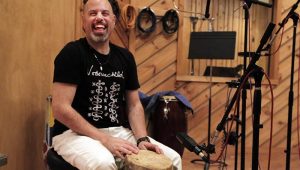Ches Smith’s We All Break – Path of Seven Colors
As a developing musician, Smith tested his mettle in series of math-laced jazz and rock settings, honing a versatile percussive vocabulary steeped in meticulously stacked metrics. The art/noise rock band Xiu Xiu and the ensembles of Tim Berne, Marc Ribot and John Zorn have all been powered by his deviously complex polyrhythms. Sideman activity a frequent priority, Smith’s sessions as a leader were comparatively sporadic, at least on record. We All Break is arguably among the most courageous of that yield so far, as it borrows and extrapolates from a cultural reservoir that isn’t technically Smith’s own.
Smith’s embrace of the responsibility and fealty inherent with interpreting the traditions was magnified by the sobering realization that audiences and listeners were sometimes mistaking elements of Vodou rhythms in his playing as original inventions. Seeking to correct the record by crediting and uplifting these Haitian sources, Smith set about enlisting colleagues and contexts with direct ties to them. The band We All Break was born. Goals for an inaugural album (included as a bonus) were focused and modest. Smith and pianist Matt Mitchell repurposed facets of their instruments to fulfill percussive roles conventionally covered by hand drums. Percussionist Daniel Brevil and Markus Schwartz fielded traditional tanbou drums with the former supplying chant-ready lyrics, both traditional and original.
Seven pieces delve deep into the myriad possibilities of these ingredients. Mitchell is frequently in charge of advancing ostinatos and elaborating melodic material while Smith serves as flexible rhythmic fulcrum between the spinning and caroming percolations of Brevil and Schwartz as on the sprint of an opener, “An Opening.” “Reds” starkly juxtaposes dark and light piano patterns with tight tanbou framing. “Dagger” is an extended foray into escalating ostinato momentum and energy while the closing “Six A.M.” moves from rapid, centripetal economy in its initial minutes to celebratory, chant-propelled ebullience across its galvanizing closing ones.
A lacuna of five years separates the titular album from its progenitor. Smith used the time to ponder at length how best to build on the precedence. Inspired decisions included amplifying the lyrical emphasis and doubling the group’s size to include altoist Miguel Zenon, bassist Nick Dunston, vocalist Sirene Dantor Rene and Fanfan Jean-Guy Rene on third tanbou. With what equates to a full jazz rhythm section plus reed in play, the dynamic is immediately fuller and more polished, but the band loses none of its collective intensity and adaptability. Smith’s sagaciously wielded sticks thread and stitch seamlessly through it all, sustaining an exciting equilibrium between reverence and respectful revision that at once honors and elevates his adopted antecedents.









